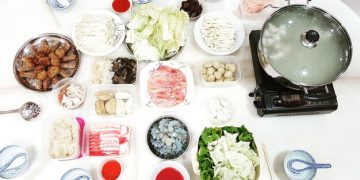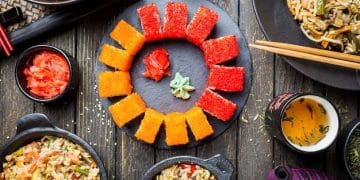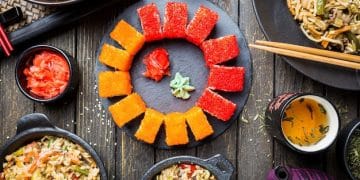The Art of Kimchi Making: A Step-by-Step Guide for US Home Cooks

The Art of Kimchi Making: A Step-by-Step Guide for US Home Cooks explores the history, health benefits, and detailed process of making kimchi, offering a comprehensive guide tailored for American home cooks to easily create this traditional Korean dish.
Discover the vibrant world of kimchi making with our comprehensive guide, tailored specifically for home cooks in the United States. Unlock the secrets to creating authentic, delicious kimchi right in your kitchen. Get ready to explore the art of kimchi making: a step-by-step guide for US home cooks.
Understanding Kimchi: A Korean Culinary Staple
Kimchi is more than just a side dish; it’s a cultural icon in Korea. Understanding its history and variations can enhance your kimchi-making experience. Let’s delve into what makes kimchi so special and why it has captured the hearts (and taste buds) of people around the world.
The History of Kimchi
Kimchi’s origins can be traced back thousands of years. Initially, it was a method of preserving vegetables for the harsh winter months. Over time, it evolved from simple salted vegetables to the complex, fermented dish we know today.
Different Types of Kimchi
There are hundreds of variations of kimchi, each with its unique ingredients and flavors. From the common baechu kimchi (napa cabbage kimchi) to the refreshing kkakdugi (radish kimchi), the possibilities are endless.
- Baechu Kimchi: The most common type, made with napa cabbage and a variety of spices.
- Kkakdugi: Made with cubed radish, known for its crunchy texture and slightly sweet flavor.
- Gat Kimchi: Made with mustard leaves, offering a peppery and slightly bitter taste.
- Oi Sobagi: Cucumber kimchi, a refreshing summer variation.
Understanding these basics will set you up for success as you embark on your kimchi-making journey. Each type offers a different flavor profile, so feel free to experiment and find your favorite.

Essential Ingredients for Authentic Kimchi
The key to delicious kimchi lies in using high-quality, fresh ingredients. While substitutions are possible, sticking to authentic Korean ingredients will yield the best results. Let’s explore the must-have items for your kimchi recipe.
Core Vegetables
Napa cabbage is the most common base, but radishes, cucumbers, and scallions are also frequently used. Choose vegetables that are firm and fresh for the best texture.
Key Seasonings
Gochugaru (Korean chili flakes) is essential for kimchi’s signature spicy flavor and vibrant color. Garlic, ginger, and fish sauce (or salted shrimp) provide depth and umami.
- Gochugaru: Korean chili flakes that provide heat and color.
- Garlic and Ginger: Aromatic ingredients that add depth of flavor.
- Fish Sauce (or Salted Shrimp): Provides umami and helps with fermentation.
- Salt: Crucial for the initial salting of the cabbage.
Sourcing these ingredients from a Korean grocery store or online supplier will ensure the most authentic flavor. Don’t be afraid to experiment with different ratios to find your preferred spice level.
Step-by-Step Guide to Making Kimchi
Making kimchi at home might seem daunting, but it’s a straightforward process. Following these steps will guide you through each stage, from preparing the cabbage to fermenting the final product. Let’s break down the process into manageable steps.
Preparing the Cabbage
Start by salting the napa cabbage to draw out excess moisture. This step is crucial for achieving the right texture and preventing spoilage. Rinse the cabbage thoroughly after salting.
Making the Kimchi Paste
Combine gochugaru, garlic, ginger, fish sauce, and other seasonings to create the flavorful kimchi paste. Adjust the spice level to your preference.
- Salting the Cabbage: This helps remove excess moisture and tenderizes the cabbage.
- Mixing the Paste: Combine all seasonings to create a flavorful base.
- Applying the Paste: Thoroughly coat the cabbage leaves with the kimchi paste.
- Packing the Kimchi: Place the kimchi in an airtight container, pressing down to remove air pockets.
With the right technique, you’ll be able to produce kimchi that is both flavorful and visually appealing. Remember to taste and adjust the seasonings as you go to achieve your desired flavor profile.
Fermentation: The Key to Flavor and Probiotics
Fermentation is what gives kimchi its unique tangy flavor and probiotic benefits. Understanding how fermentation works will help you achieve the perfect taste and texture.
Understanding the Fermentation Process
Fermentation occurs when beneficial bacteria convert sugars into lactic acid. This process preserves the kimchi and creates its characteristic sourness.
Optimal Fermentation Conditions
The ideal temperature for fermenting kimchi is between 60-70°F (15-21°C). Store the kimchi in a cool, dark place for the best results.
Monitoring the fermentation process is key to achieving the perfect balance of flavors. Too little fermentation and the kimchi will be bland; too much, and it will be overly sour.

Tips for Perfect Kimchi Every Time
Even with a solid recipe, some extra tips can help you elevate your kimchi-making skills. These insights will ensure consistent results and delicious flavors.
Choosing the Right Ingredients
Opt for fresh, high-quality ingredients. The quality of your vegetables and seasonings will directly impact the flavor of your kimchi.
Adjusting the Spice Level
Adjust the amount of gochugaru to control the spice level. Start with a smaller amount and add more to taste.
- Use Fresh Ingredients: High-quality vegetables and seasonings are essential.
- Control the Spice: Adjust the amount of gochugaru to your liking.
- Pack Tightly: Press the kimchi into the container to remove air pockets.
- Monitor Fermentation: Check the kimchi daily and adjust the timing based on taste.
By following these tips, you’ll be well on your way to making kimchi that rivals the best Korean restaurants. Experiment with different ingredients and techniques to find what works best for your taste preferences.
Serving and Storing Your Homemade Kimchi
Once your kimchi is perfectly fermented, it’s time to enjoy the fruits of your labor. Proper serving and storage techniques will help maintain its flavor and quality.
Serving Suggestions
Kimchi can be enjoyed as a side dish, added to stews and soups, or used as an ingredient in dishes like kimchi fried rice. Its versatility makes it a staple in Korean cuisine.
Proper Storage Techniques
Store kimchi in an airtight container in the refrigerator. Properly stored kimchi can last for several months, although the flavor will continue to evolve over time.
- Side Dish: Enjoy it alongside rice, meat, or vegetables.
- Ingredient: Incorporate it into soups, stews, and fried rice.
- Refrigeration: Store in an airtight container to maintain freshness.
- Long-Term Storage: Kimchi can last for months in the refrigerator, with the flavor becoming more intense over time.
Kimchi is a versatile ingredient that can enhance a wide range of dishes. Experiment with different ways to incorporate it into your meals and discover your favorite combinations.
| Key Aspect | Brief Description |
|---|---|
| 🥬 Cabbage Prep | Salting cabbage is crucial for texture and preventing spoilage. |
| 🌶️ Kimchi Paste | Combine gochugaru, garlic, ginger, and fish sauce for flavor. |
| 🌡️ Fermentation | Ferment at 60-70°F for optimal flavor and probiotic benefits. |
| 📦 Storage | Keep in an airtight container in the refrigerator for months. |
Chave em Kimchi Making
▼
Napa cabbage is the most commonly used and recommended cabbage for kimchi. Its slightly sweet flavor and crisp texture make it ideal for fermentation.
▼
Yes, you can substitute fish sauce with other umami-rich ingredients like soy sauce or a vegetarian mushroom broth to create a vegan-friendly version.
▼
Kimchi typically ferments for 3-7 days at room temperature, depending on your taste preferences. The longer it ferments, the sourer it becomes.
▼
You’ll know your kimchi is ready when it has a tangy, sour smell and taste. Small bubbles may also appear in the jar, indicating active fermentation.
▼
Yes, kimchi is very healthy! It is packed with probiotics, vitamins, and antioxidants, which support gut health and boost the immune system.
Conclusion
Mastering the art of kimchi making is a rewarding culinary journey that connects you to Korean culture and provides a delicious, healthy staple for your table. Embrace the process, experiment with flavors, and enjoy the unique taste of homemade kimchi.





